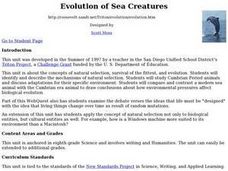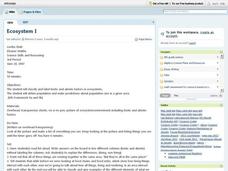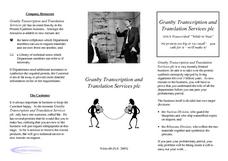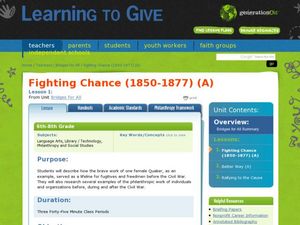Curated OER
U2
Students examine the cover of a compact disc from U2 and describe what they see. They match words in English with other languages. They discover the meanings of words they do not know from the songs.
Curated OER
Refugees
Learners investigate the affect of refugees have one their host country. They examine where refugees go and decide on things that might be affected by their influx such as medical care, moral issues, economic issues, and language barriers.
Curated OER
Oranges and Stopwatches
Students measure various attributes of an orange. They discuss the attributes of an orange that can be measured, develop a list of attributes and describe how they can measure it, and rotate through four stations measuring the volume,...
Curated OER
My Name is Osama - Bullying and Name-Calling
Learners read the story of an Iraqi immigrant boy named Osama who faces taunts of terrorist in his U.S. school after the attack of September 11.
They discuss the characters and their struggles in the story. Students respond to...
Curated OER
Wildlife on the African Savanna
Second graders discuss African Savanna, choose and illustrate example of wildlife that is found in the Savanna, and write paragraph describing wildlife they chose to draw.
Curated OER
Reporting Back
Students review what it means of being an informed voter. They present their cartoons or quotes work to the class. Youth Summit delegates share impressions of the Summit. They include new information that they obtained and individual...
Curated OER
Color My World
Students identify colors created by mixing primary colors and describe the process. They then design a book using the colors of a given season entitled "Colors of the Season".
Curated OER
Magnets-The Quicker Picker Upper
Second graders research the design of and purpose of magnets. They investigate a group of objects to discover which things are attracted to magnets. Observe the effect that lodestone has on iron fillings. Summarize observations.
Curated OER
How Economic Systems Developed
Young scholars explain the basic functions of the various economic systems. As a class, they identify the main characteristics of capitalism and the advantages of division of labor and specialization. They describe the relationship...
Curated OER
The Giving Tree
Young scholars investigate the virtue of kindness and giving by conducting a children's literature study of "The Giving Tree". They make a list of words to describe emotions in the story and write a journal daily while looking at the...
Curated OER
What is the Composition of Soil?
Students examine the different components that make up soil. Using data, they identify the components of soil in their local area and discover how scientists use the soil to see how it was formed. They also describe the soil forming...
Curated OER
Evolution of Sea Creatures
Students identify and describe the mechanisms of natural selection. They study Cambrian Period animals and discuss adaptations for their specific environment.Students compare and contrast a modern sea animal with the Cambrian era animal...
Curated OER
Creating a Decorative Drawer Front Concealing Student Treasures
Sixth graders describe the image of a writing desk. They create a separate drawer to scale and create a class desk that displays each drawer. Students use repetitive motifs in designing their drawers. To illustrate the use of the desk in...
Curated OER
Different Environments
Students read literature selection, discuss habitat, divide habitats into different categories such as water, soil, and land, list animals that live in each habitat, and describe habitats using descriptive words in vocabulary list.
Curated OER
Darwin vs Lamarck
Ninth graders describe variations in organisms and compare and contrast the evolutionary theories of Darwin and Lamarck. Students copy the definition of various given words and where they think they came from. They have to relate it to...
Curated OER
Ecosystem I
Students classify and label biotic and a-biotic factors in ecosystems. They define population and make predictions about population size in a given area. They describe the a-biotic factors' importance and impact on the other elements...
Curated OER
Sexual Versus Asexual Reproduction
Students discuss the prefix "a" as in atypical and abiotic. They coy definitions of sexual and asexual reproduction into their notes. Students use prior knowledge of mitosis, meiosis, and previous diagrams to describe what happens in...
Curated OER
Newton's Third Law
Students describe an everyday situation which demonstrates Newton's Third Law. They state Newton's Third Law;"Every action has an equal and opposite re-action, or every force has an equal and opposite force" in their own words. ...
Curated OER
Elementary Lesson Plan
Students explore and describe the characteristics of music from the Classical period. They work in groups to compose an eight bar 2 part line utilizing Sibelius and explains their melody line and how it is similar to the Classical period.
Curated OER
DNA Transcribed
In this DNA worksheet, students describe how the cell stores all of the data needed to produce the required proteins for the body. Then they describe the ribosomes division and how is attaches itself to RNA and makes protein by forming...
Curated OER
Total English Upper Intermediate: Making Comparisons
In this making comparisons instructional activity, students expand 8 prompts as they write complete sentences that make comparisons. Students also use comparative and superlative adjectives to compare the places the describe.
Curated OER
Bridges for All
Pupils describe how the brave word of one female Quaker served as a lifeline for fugitives before the Civil War. In this research lesson, students research several examples of the philanthropic work of individuals and organizations...
Alabama Learning Exchange
Botany Scavenger Hunt Where's the Ginkgo?
Learners use a science journal to log plants that are native to Alabama. In this plant lesson plan, students identify characteristics, describe environments, and classify the plants that they find.
Curated OER
Take a Look in the Mirror: What Do You See?
Students examine their perceptions of themselves. In this personal health lesson, students participate in a classroom activity that requires them to describe themselves and share those descriptions with their classmates. Students also...























